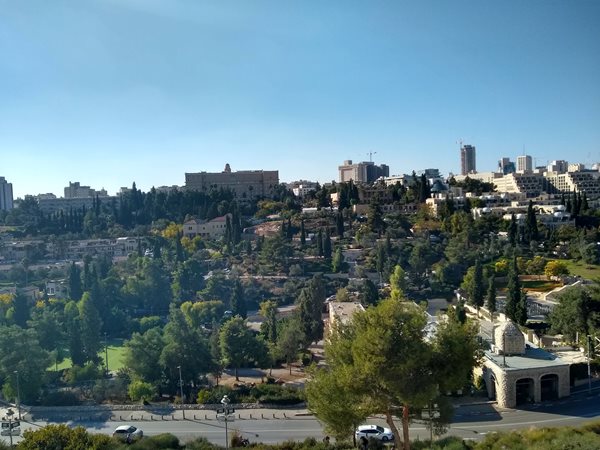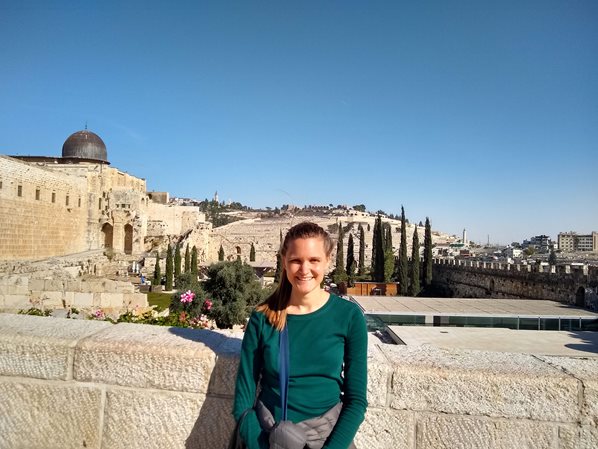Faith Today circulation coordinator Rachel Baarda recounts her visit to Jerusalem as part of a tour for Christian journalists sponsored by the Israel Ministry of Tourism.
In November, I traveled to Israel with three Christian journalists from the United States on a trip hosted by the Israel Ministry of Tourism.
We reached Jerusalem on the fifth day of our tour. There, we learned of a little-known opportunity for tourists to walk on the walls of the Old City of Jerusalem. On a sunny Sabbath afternoon with only one or two other people occasionally passing by, I and the three others on my tour walked the ramparts of Jerusalem overlooking the new city of Jerusalem beyond, the old City within and the Old City of David in the distance.

Our 1.5-km trek on the 500-year-old stone walls took us past some of Israel’s gates such as the Jaffa Gate and the Dung Gate, while the Dome of the Rock gleamed near Mount Moriah in the near distance. I was reminded of this verse, "Walk about Zion, go around her. Count her towers, consider well her ramparts, view her citadels, that you may tell of them to the next generation" (Psalm 48:12-13).
After our walk, I wondered, “Why does the psalmist urge us to know Jerusalem so deeply that we might describe the city to the next generation?”
Jerusalem’s Past
Jerusalem was formerly a Jebusite city until it was conquered by David, who built his palace there. Then his son Solomon built the first temple. By the time Jeremiah was warning of its impending destruction, Jerusalem was a strong, bustling city. The original walls of Jerusalem were about 2.5 m thick, the same width as today’s Jerusalem walls. While those original walls are mostly gone, we saw archeological remnants of market stalls, homes, and – yes – idols, not life-size images, but small “pocket-size” wooden carvings. The Jewish people of the day would have found it easy to trust in the expertise of the city’s builders, the sheer breadth of the perimeter, or the small pagan figurines they could feel with their hands.
 As Christians today, we may be inclined to scoff at the leaders and false prophets who dismissed Jeremiah’s warnings and threw him into the cistern. How could they just close their ears to his pleas? Couldn’t they just throw away their idols? But as our tour guide pointed out, we have “pocket-size” idols today, too. Who doesn’t feel a little safer when we pat our jeans and feel the solid outline of a familiar electronic device that acts as our second brain? Electronics, technology and scientific expertise are so pervasive in our society that God can seem almost unnecessary. If a prophet arrived in North America today and warned us of destruction if we refused to repent of our own idolatry, what kind of treatment would he face?
As Christians today, we may be inclined to scoff at the leaders and false prophets who dismissed Jeremiah’s warnings and threw him into the cistern. How could they just close their ears to his pleas? Couldn’t they just throw away their idols? But as our tour guide pointed out, we have “pocket-size” idols today, too. Who doesn’t feel a little safer when we pat our jeans and feel the solid outline of a familiar electronic device that acts as our second brain? Electronics, technology and scientific expertise are so pervasive in our society that God can seem almost unnecessary. If a prophet arrived in North America today and warned us of destruction if we refused to repent of our own idolatry, what kind of treatment would he face?
Our tour guide showed us the remnants of what is believed to have been David’s palace, where archaeologists discovered seals from two of Zedekiah’s government ministers, Jehucal and Gedaliah, both named in the Bible. Angry at the prophecies of Jerusalem’s destruction, Gedaliah lobbied for Jeremiah to be executed (Jeremiah 38). Not long after, the Babylonians did invade the city and set fire to the palace, burning up letters and leaving behind only a few seals. Gedaliah’s abandoned seal is a reminder to our modern generation of the vulnerability of governments and people who place their trust in the idols of the day over God.

Jerusalem Today
Jerusalem today is a vibrant centre of pluralism, but also of tension. The city is divided into quarters, and we walked and browsed stores in all of them—the Armenian, Christian, Muslim and Jewish quarters—mingling with many tourists from all nations around the world. Standing above the Old City of David in the morning, I could hear the Muslim call to prayer reverberating from different locations over the hills, even as tourists and others in the city carried on their own business. For the three days we were there, Jerusalem felt like a remarkable testament to interfaith and intercultural harmony. Nonetheless, there were two separate bus bombings on the outskirts of Jerusalem only two days after we left Jerusalem. One Israeli-Canadian teenage boy died, and another man died later in hospital. More than twenty other people were injured. The fragile peace of Jerusalem reminds us of the tenuous nature of pluralism in a world torn by religious and cultural divisions.

Jerusalem of the Future
Before we entered Jerusalem, we were able to view the Old City from the Mount of Olives, east of the Old City of Jerusalem. The Mount of Olives is the place not only where Jesus ascended to heaven, but also where Zechariah 14 says He will set foot when He returns.
If you stand on the Mount of Olives, you can view the face of the Old City wall and the Golden Gate near the former site of the temple. In 1541, the Golden Gate was sealed by the Ottoman Sultan Suleiman, out of fear that the Jewish Messiah would enter through the gate. Some Jewish and Christian scholars believe Jesus will re-enter Jerusalem through this gate, as He once did on Palm Sunday. Then He was the soon-to-be rejected Saviour. This time He will arrive as king over the earth.
 For most of us in North America, Jerusalem is a distant place, one we only read about in the Bible or occasionally hear about on the news, often in relation to terror attacks. But the Bible depicts Jerusalem when Jesus is reigning as the centre of world religion, travel and government. Zechariah 14:14-15 says, “Then the survivors from all the nations that have attacked Jerusalem will go up year after year to worship the King, the Lord Almighty, and to celebrate the Festival of Tabernacles.”
For most of us in North America, Jerusalem is a distant place, one we only read about in the Bible or occasionally hear about on the news, often in relation to terror attacks. But the Bible depicts Jerusalem when Jesus is reigning as the centre of world religion, travel and government. Zechariah 14:14-15 says, “Then the survivors from all the nations that have attacked Jerusalem will go up year after year to worship the King, the Lord Almighty, and to celebrate the Festival of Tabernacles.”
In the world where Jesus reigns from Jerusalem, humankind will recognize that no other form of government – neither democracy nor dictatorship, conservative nor liberal – can bring any kind of lasting peace. Christ Himself will set the ultimate standard.
Ezekiel vividly describes a new temple in Jerusalem, and closes his writings with these words: “And the name of the city from that time on will be: the Lord is there” (Ezekiel 48:35). It echoes phrases like, “My name will remain in Jerusalem forever” (2 Chronicles 33:3) and “The Lord has chosen Jerusalem and will dwell there forever” (Psalm 132:13-14).
In Revelation 21, the apostle John envisions a New Jerusalem on the new earth where God will dwell with His people. This kind of image informs why the psalmist vows to always consider Jerusalem his “highest joy” (Psalm 137:6). Jerusalem has for centuries been the place God chose to reveal His desire to live with His people. Visiting Jerusalem and walking its ramparts gave me a tangible connection to the promise that, despite God’s often turbulent relationship with humankind, He intends to make a home among us forever.
Rachel Baarda of Ottawa is distribution and circulation coordinator for Faith Today. This article is sponsored by Israel Tourism.
From top to bottom:
Photo 1: View of the new city of Jerusalem from the ramparts
Photo 2: On top of the Old City walls, a short walk from the Jaffa Gate
Photo 3: Archaeological findings of a structure believed to be David's palace
Photo 4: Rachel in front of the Al-Aqsa mosque, a short walk from the Western Wall
Photo 5: View of the Old City from the Mount of Olives, with the Golden Gate (Eastern Gate) to the right of the Dome of the Rock
Video: Overlooking the Armenian Quarter from the ramparts